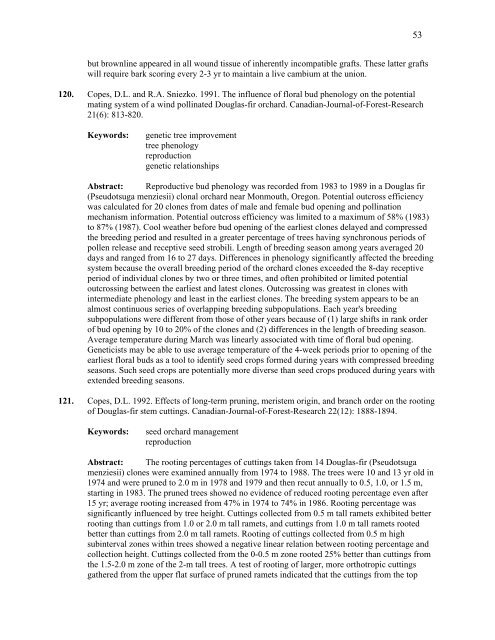IntensIve sIlvIculture - Forest Science Labs - Research Network ...
IntensIve sIlvIculture - Forest Science Labs - Research Network ...
IntensIve sIlvIculture - Forest Science Labs - Research Network ...
Create successful ePaper yourself
Turn your PDF publications into a flip-book with our unique Google optimized e-Paper software.
ut brownline appeared in all wound tissue of inherently incompatible grafts. These latter grafts<br />
will require bark scoring every 2-3 yr to maintain a live cambium at the union.<br />
120. Copes, D.L. and R.A. Sniezko. 1991. The influence of floral bud phenology on the potential<br />
mating system of a wind pollinated Douglas-fir orchard. Canadian-Journal-of-<strong>Forest</strong>-<strong>Research</strong><br />
21(6): 813-820.<br />
Keywords: genetic tree improvement<br />
tree phenology<br />
reproduction<br />
genetic relationships<br />
Abstract: Reproductive bud phenology was recorded from 1983 to 1989 in a Douglas fir<br />
(Pseudotsuga menziesii) clonal orchard near Monmouth, Oregon. Potential outcross efficiency<br />
was calculated for 20 clones from dates of male and female bud opening and pollination<br />
mechanism information. Potential outcross efficiency was limited to a maximum of 58% (1983)<br />
to 87% (1987). Cool weather before bud opening of the earliest clones delayed and compressed<br />
the breeding period and resulted in a greater percentage of trees having synchronous periods of<br />
pollen release and receptive seed strobili. Length of breeding season among years averaged 20<br />
days and ranged from 16 to 27 days. Differences in phenology significantly affected the breeding<br />
system because the overall breeding period of the orchard clones exceeded the 8-day receptive<br />
period of individual clones by two or three times, and often prohibited or limited potential<br />
outcrossing between the earliest and latest clones. Outcrossing was greatest in clones with<br />
intermediate phenology and least in the earliest clones. The breeding system appears to be an<br />
almost continuous series of overlapping breeding subpopulations. Each year's breeding<br />
subpopulations were different from those of other years because of (1) large shifts in rank order<br />
of bud opening by 10 to 20% of the clones and (2) differences in the length of breeding season.<br />
Average temperature during March was linearly associated with time of floral bud opening.<br />
Geneticists may be able to use average temperature of the 4-week periods prior to opening of the<br />
earliest floral buds as a tool to identify seed crops formed during years with compressed breeding<br />
seasons. Such seed crops are potentially more diverse than seed crops produced during years with<br />
extended breeding seasons.<br />
121. Copes, D.L. 1992. Effects of long-term pruning, meristem origin, and branch order on the rooting<br />
of Douglas-fir stem cuttings. Canadian-Journal-of-<strong>Forest</strong>-<strong>Research</strong> 22(12): 1888-1894.<br />
Keywords: seed orchard management<br />
reproduction<br />
Abstract: The rooting percentages of cuttings taken from 14 Douglas-fir (Pseudotsuga<br />
menziesii) clones were examined annually from 1974 to 1988. The trees were 10 and 13 yr old in<br />
1974 and were pruned to 2.0 m in 1978 and 1979 and then recut annually to 0.5, 1.0, or 1.5 m,<br />
starting in 1983. The pruned trees showed no evidence of reduced rooting percentage even after<br />
15 yr; average rooting increased from 47% in 1974 to 74% in 1986. Rooting percentage was<br />
significantly influenced by tree height. Cuttings collected from 0.5 m tall ramets exhibited better<br />
rooting than cuttings from 1.0 or 2.0 m tall ramets, and cuttings from 1.0 m tall ramets rooted<br />
better than cuttings from 2.0 m tall ramets. Rooting of cuttings collected from 0.5 m high<br />
subinterval zones within trees showed a negative linear relation between rooting percentage and<br />
collection height. Cuttings collected from the 0-0.5 m zone rooted 25% better than cuttings from<br />
the 1.5-2.0 m zone of the 2-m tall trees. A test of rooting of larger, more orthotropic cuttings<br />
gathered from the upper flat surface of pruned ramets indicated that the cuttings from the top<br />
53
















